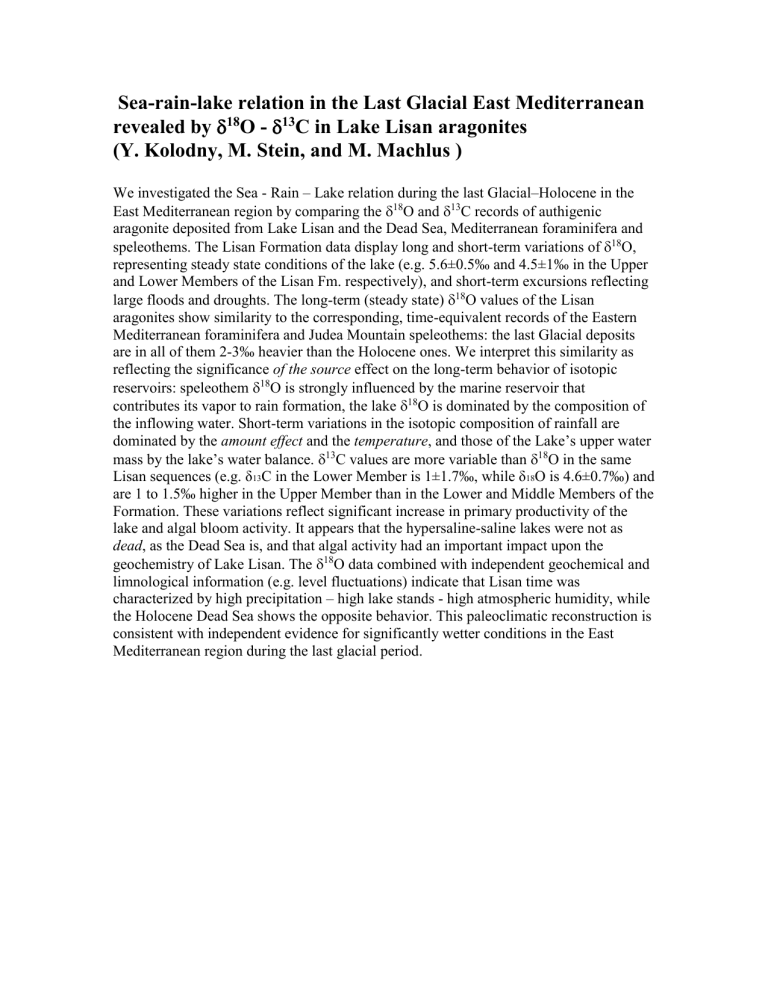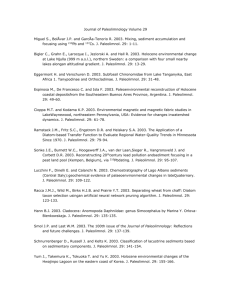Dead Sea and Jordan Rift Valley paleoclimate and seismic research

Sea-rain-lake relation in the Last Glacial East Mediterranean revealed by
18
O -
13
C in Lake Lisan aragonites
(Y. Kolodny, M. Stein, and M. Machlus )
We investigated the Sea - Rain – Lake relation during the last Glacial–Holocene in the
East Mediterranean region by comparing the
18
O and
13
C records of authigenic aragonite deposited from Lake Lisan and the Dead Sea, Mediterranean foraminifera and speleothems. The Lisan Formation data display long and short-term variations of
18
O, representing steady state conditions of the lake (e.g. 5.6±0.5‰ and 4.5±1‰ in the Upper and Lower Members of the Lisan Fm. respectively), and short-term excursions reflecting large floods and droughts. The long-term (steady state)
18 O values of the Lisan aragonites show similarity to the corresponding, time-equivalent records of the Eastern
Mediterranean foraminifera and Judea Mountain speleothems: the last Glacial deposits are in all of them 2-3‰ heavier than the Holocene ones. We interpret this similarity as reflecting the significance of the source effect on the long-term behavior of isotopic reservoirs: speleothem
18 O is strongly influenced by the marine reservoir that contributes its vapor to rain formation, the lake
18 O is dominated by the composition of the inflowing water. Short-term variations in the isotopic composition of rainfall are dominated by the amount effect and the temperature
, and those of the Lake’s upper water mass by the lake’s water balance. 13
C values are more variable than
18
O in the same
Lisan sequences (e.g. δ
13
C in the Lower Member is 1±1.7‰, while δ
18
O is 4.6±0.7‰) and are 1 to 1.5‰ higher in the Upper Member than in the Lower and Middle Members of the
Formation. These variations reflect significant increase in primary productivity of the lake and algal bloom activity. It appears that the hypersaline-saline lakes were not as dead , as the Dead Sea is, and that algal activity had an important impact upon the geochemistry of Lake Lisan. The
18 O data combined with independent geochemical and limnological information (e.g. level fluctuations) indicate that Lisan time was characterized by high precipitation – high lake stands - high atmospheric humidity, while the Holocene Dead Sea shows the opposite behavior. This paleoclimatic reconstruction is consistent with independent evidence for significantly wetter conditions in the East
Mediterranean region during the last glacial period.
Seventy thousand year record of δ
18
O changes in (a) marine foraminifera G. ruber
(Fontugne and Calvert, 1992), b. Speleothem from Soreq cave (Bar-Matthews et al.,
2003), c. aragonite laminae from the Lisan Formation (this work) and d. Lake Lisan levels (Bartov et al., 2002, 2003). The vertical, thick, line marks the Pleistocene-
Holocene transition at 10kyr. Note the depositional gap (marked by a question mark) between 14.5 kyr and the onset of the Holocene. Also marked is the transition from a two lake to a one-lake configuration. Only between the two thin, vertical lines (24 to 26 kyr
BP) did a single lake exist in the rift valley.










